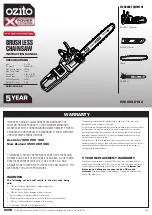
MAINTENANCE
SHARPENING THE CUTTERS (Fig. 53 - 56)
PARTS OF A CUTTER
(
A
) Cutting Corner
(
E
) Gullet
(
B
) Side Plate
(
F
) Heel
(
C
) Depth Gauge
(
G
) Rivet hole
(
D
) Toe
(
H
) Top Plate
Be careful to file all cutters to the specified angles and to
the same length, as fast cutting can only be obtained
when all cutters are uniform.
1. Wear gloves for protection.
2. Tension the chain prior to sharpening.
NOTE:
Refer to “Maintenance – Adjusting the Chain
Tension” earlier in this manual.
3. Use a 4 mm (5/32 in.) diameter round file and holder.
Do all your filing at the midpoint of the bar.
4. Keep the file level with the top plate of the tooth.
Do not let the file dip or rock.
5. Using light but firm pressure, stroke towards the front
corner of the tooth.
6. Lift the file away from the steel on each return stroke.
7. Put a few firm strokes on every tooth. File all-left
hand cutters (
A
) in one direction. Then move to the
other side and file the right-hand cutters (
B
) in the
opposite direction.
8. Remove filings from the file with a wire brush.
CAUTION
A dull or improperly sharpened chain can cause
excessive engine speed during cutting which
may result in severe engine damage.
WARNING
Improper chain sharpening increases the
potential of kick-back.
WARNING
Failure to replace or repair a damaged chain can
cause serious injury.
WARNING
The saw chain is very sharp. Always wear
protective gloves when performing maintenance
to the chain.
TOP PLATE FILING ANGLE (Fig. 57)
■
(
A
) - CORRECT 30° – file holders are marked with
guide marks to align file properly to produce correct
top plate angle.
■
(
B
) - LESS THAN 30° – for cross cutting.
■
(
C
) - MORE THAN 30° – feathered edge dulls quickly.
SIDE PLATE ANGLE (Fig. 58)
■
(
D
) - CORRECT 80° – Produced automatically if you
use the correct diameter file in the file holder.
■
(
E
) - HOOK – “Grabs” and dulls quickly, increases the
potential of KICK-BACK. Results from using a file with
a diameter too small or a file held too low.
■
(
F
) - BACKWARD SLOPE – Needs too much feed
pressure, causes excessive wear to the bar and
chain. Results from using a file with a diameter too
large or file held too high.
MAINTAINING DEPTH GAUGE CLEARANCE
(Fig. 51, 59 & 60)
■
Maintain the depth gauge (
A
) at a clearance of
0.6 mm (0.025 in.). Use a depth gauge tool for
checking the depth gauge clearances.
■
Every time the chain is filed, check the depth gauge
clearance.
■
Use a flat file (
B
) (not provided) and a depth gauge
jointer (
C
) (not provided) to lower all gauges uniformly.
Use a 0.6 mm (0.025 in.) depth gauge jointer.
After lowering each depth gauge, restore original
shape by rounding the front (
D
). Be careful not to
damage adjoining drive links with the edge of the file.
■
Depth gauges must be adjusted with the flat file in the
same direction the adjoining cutter was filed with the
round file. Use care not to contact cutter face with flat
file when adjusting depth gauges.
MAINTAINING THE GUIDE BAR (Fig. 61)
CAUTION
Make sure the chain has stopped before you do
any work on the saw.
Every week of use, reverse the guide bar on the saw
to distribute the wear for maximum bar life.The bar
should be cleaned every day of use and checked for
wear and damage.
Feathering or burring of the bar rails is a normal process
of bar wear. Such faults should be smoothed with a file
as soon as they occur.
A bar with any of the following faults should be replaced:
■
Wear inside the bar rails which permits the chain to
lie over sideways;
■
Bent guide bar;
■
Cracked or broken rails;
■
Spread rails.
12
English
PCN 4040_4545 manual
Summary of Contents for PCN 4040
Page 1: ...N197 PCN 4040 CHAINSAW OWNER S OPERATION MANUAL...
Page 2: ......
Page 3: ...STOP...
Page 4: ......
Page 5: ......
Page 6: ......
Page 13: ...6...






































